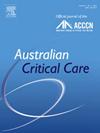Can handgrip strength reflect muscle dysfunction in individuals in intensive care units? A prospective observational study
IF 2.7
3区 医学
Q2 CRITICAL CARE MEDICINE
引用次数: 0
Abstract
Background
Handgrip strength (HGS) is a tool for diagnosing intensive care unit (ICU)–acquired weakness. However, the influence of consciousness on HGS and its relationship with muscle dysfunction in the ICU remain unclear.
Objectives
This prospective observational study evaluated the feasibility, reliability, and performance of HGS in patients in the ICU with varying levels of consciousness and compared changes in muscle mass and HGS between patients with improved or worsened consciousness during their ICU stay.
Methods
Critically ill patients in surgical ICUs were assessed daily for HGS, quadriceps muscle thickness, and diaphragm thickness, along with consciousness evaluations using the Richmond Agitation-Sedation Scale (RASS). Muscle thickness was assessed by ultrasound. Patients were categorised into worsened, stable, or improved groups based on RASS score changes. The intraclass correlation coefficient assessed the HGS reliability across consciousness levels. Independent t-tests compared HGS and muscle thickness between patients with better consciousness (RASS −1 to 1) and poorer consciousness (RASS outside −1 to 1). Generalised estimating equations explored HGS and muscle thickness trends between the worsened and improved groups during the ICU stay.
Results
A total of 318 patients (mean age: 66.1 years; 32.4% female) were included in the study. HGS reliability was good in patients with RASS scores of 0 (intraclass correlation coefficient = 0.869). Patients with better consciousness displayed significantly higher HGS and quadriceps thickness than those with poorer consciousness. During ICU stay, HGS increased by 50% in the improved group; it decreased by 22% in the worsened group, showing a significantly opposite trend (p < 0.001). The quadriceps and diaphragm thicknesses decreased in both groups, with no significant differences in the trends between them.
Conclusions
HGS assessment is feasible and reliable in ICU patients with a RASS score of 0. Improvements in HGS in critically ill patients are associated with improved consciousness rather than muscle mass gain.
在重症监护病房的个体中,握力能反映肌肉功能障碍吗?一项前瞻性观察研究。
背景:握力(HGS)是诊断重症监护病房(ICU)获得性虚弱的一种工具。然而,意识对ICU患者HGS的影响及其与肌肉功能障碍的关系尚不清楚。目的:本前瞻性观察性研究评估了HGS在不同意识水平ICU患者中的可行性、可靠性和性能,并比较了意识改善或恶化患者在ICU住院期间肌肉质量和HGS的变化。方法:对外科重症监护室危重患者每日进行HGS、股四头肌厚度和膈肌厚度评估,并使用Richmond躁动-镇静量表(RASS)进行意识评估。超声测量肌肉厚度。根据RASS评分的变化将患者分为恶化组、稳定组和改善组。类内相关系数评估HGS在意识水平上的信度。独立t检验比较了意识较好(RASS -1 ~ 1)和意识较差(RASS -1 ~ 1)患者的HGS和肌肉厚度。广义估计方程探讨了ICU住院期间恶化组和改善组之间HGS和肌肉厚度的趋势。结果:共纳入318例患者,平均年龄66.1岁,女性32.4%。RASS评分为0的患者HGS信度较好(类内相关系数= 0.869)。意识较好的患者HGS和股四头肌厚度明显高于意识较差的患者。ICU住院期间,改善组HGS提高50%;恶化组下降22%,呈现明显相反的趋势(p < 0.001)。两组的股四头肌和横膈膜厚度均下降,趋势无显著差异。结论:HGS评估在RASS评分为0分的ICU患者中是可行、可靠的。危重患者HGS的改善与意识的改善有关,而不是肌肉质量的增加。
本文章由计算机程序翻译,如有差异,请以英文原文为准。
求助全文
约1分钟内获得全文
求助全文
来源期刊

Australian Critical Care
NURSING-NURSING
CiteScore
4.90
自引率
9.10%
发文量
148
审稿时长
>12 weeks
期刊介绍:
Australian Critical Care is the official journal of the Australian College of Critical Care Nurses (ACCCN). It is a bi-monthly peer-reviewed journal, providing clinically relevant research, reviews and articles of interest to the critical care community. Australian Critical Care publishes peer-reviewed scholarly papers that report research findings, research-based reviews, discussion papers and commentaries which are of interest to an international readership of critical care practitioners, educators, administrators and researchers. Interprofessional articles are welcomed.
 求助内容:
求助内容: 应助结果提醒方式:
应助结果提醒方式:


